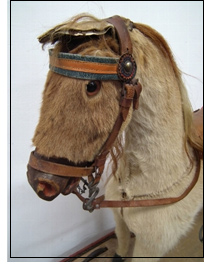featured item
Vintage toys – Rocking horses
Posted by Gillian Jones on 19/12/2013
 As vintage toys go rocking horses are an excellent find, they’re popular with collectors, perhaps not so good for children due to their age and potential lack of safety, but are beautiful to behold. Rocking horses are as popular as they once were, and dedicated restorers are bringing the old favourites back to life and there are some beauties out there for collectors and restorers alike.
As vintage toys go rocking horses are an excellent find, they’re popular with collectors, perhaps not so good for children due to their age and potential lack of safety, but are beautiful to behold. Rocking horses are as popular as they once were, and dedicated restorers are bringing the old favourites back to life and there are some beauties out there for collectors and restorers alike.
In the beginning
Rocking horses can be traced back to the Middle Ages, this is where we see the first hobby horse with a fake head attached to a pole. We still see them now. In this period we would also see the first wheeled horse. However, it wasn’t until the 17th and 18th century that we saw the first rocking horse. They made a shy first appearance in the 17th century when bow rockers were invented allowing the rocking horse to move backwards and forwards. But they did come with problems; these early prototypes of the rocking horse were made of solid wood making them prone to tipping.
The canniness of the Victorians
The Victorians would create the hollow rocking horse making it lighter and less easy to topple. They were therefore more stable and came with hidden compartments underneath which could be used to hide family heirlooms such as a baby’s lock, a coin, or anything else of interest that could be left for later generations.
If you’ve ever wondered why every rocking horse you’ve ever set eyes on is dapple grey then you have Queen Victoria to thank. Rocking horses became increasingly popular as the 19th century wore on. Queen Victoria visited the toy makers J. Collinson of Liverpool during her reign, where she purchased a dapple grey increasing the popularity of the dapple grey rocking horse tenfold. They became increasingly popular with a growing upper middle class that filled their nurseries with this equine toy.
Decline of the horse
The beginning of the twentieth century and the First World War saw the decline of the rocking horse. Later in the mid twentieth, from the sixties onwards the rocking horse made its return with dedicated fans of the rocking horse lovingly restoring it to its former glory.
Fancy starting a collection?
Rocking horses are making a comeback and there are some dedicated restorers out there, or maybe you fancy restoring one yourself? Simply collecting such exquisite toys is a joy and there are some excellent examples on www.antiques.co.uk. Starting with the old toy wooden horse, although not dated, looks very much like an early rudimentary rocking horse without the rocking part, a simple log with a horse’s head and legs. However, it would have proved just as comfortable to sit on as a traditional rocking horse.
Next, we have a small child’s horse made of fir with leather saddle and bridle from the early 20th century, again, without the rocking part, but still a rather beautiful and lifelike version.
This rocking horse made by Paterson Edwards isn’t dated, but is a more traditional horse in dapple grey with saddle and stirrups, but without the bow rocker beneath.
This rather curious fellow, an early 20th century Welsh rocking horse doesn’t look quite as horse like with its unusually shaped head, but it’s a fun piece to add to a budding collection.
Finally, a rocking horse ripe for restoration from the Georgian period, a rare find, without the bow rocker, heavily made and a classic example of the early rocking horse, this could be saved as a piece to be savoured, or restored to active use as a child’s toy.
Whatever you decide to do with your rocking horses, either restore them for active use, or simply keep them to display or sell on, they’re a worthwhile find and provide a fascinating history worthy of retelling.





